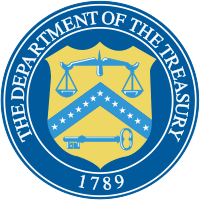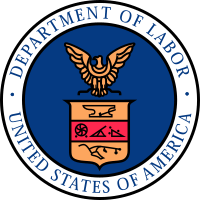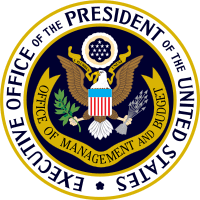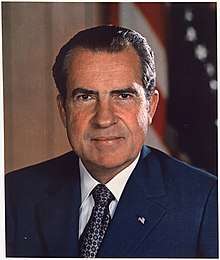George Shultz
George Pratt Shultz (/ʃʊlts/; born December 13, 1920) is an American economist, politician, and businessman. He served in various positions under three different Republican presidents and is one of only two people to have held four different Cabinet posts.[1] Shultz played a major role in shaping the foreign policy of the Ronald Reagan administration. From 1974 to 1982, he was an executive of Bechtel Group, an engineering and services company. In the 2010s, Shultz was a prominent figure in the scandal of the biotech firm Theranos, continuing to support it as a board member in the face of mounting evidence of fraud.
George Shultz | |
|---|---|
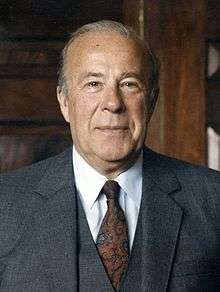 | |
| 60th United States Secretary of State | |
| In office July 16, 1982 – January 20, 1989 | |
| President | Ronald Reagan |
| Deputy | Walter J. Stoessel Jr. Kenneth W. Dam John C. Whitehead |
| Preceded by | Alexander Haig |
| Succeeded by | James Baker |
| 62nd United States Secretary of the Treasury | |
| In office June 12, 1972 – May 8, 1974 | |
| President | Richard Nixon |
| Preceded by | John Connally |
| Succeeded by | William E. Simon |
| Director of the Office of Management and Budget | |
| In office July 1, 1970 – June 11, 1972 | |
| President | Richard Nixon |
| Preceded by | Bob Mayo (Bureau of the Budget) |
| Succeeded by | Caspar Weinberger |
| 11th United States Secretary of Labor | |
| In office January 22, 1969 – July 1, 1970 | |
| President | Richard Nixon |
| Preceded by | W. Willard Wirtz |
| Succeeded by | James Day Hodgson |
| Personal details | |
| Born | George Pratt Shultz December 13, 1920 New York City, New York, U.S. |
| Political party | Republican |
| Spouse(s) | Helena O'Brien
( m. 1946; died 1995) |
| Children | 5 |
| Education | Princeton University (BA) Massachusetts Institute of Technology (MA, PhD) |
| Signature | |
| Military service | |
| Allegiance | |
| Branch/service | |
| Years of service | 1942–1945 |
| Rank | |
| Battles/wars | World War II |
Born in New York City, he graduated from Princeton University before serving in the United States Marine Corps during World War II. After the war, Shultz earned a Ph.D. in industrial economics from the Massachusetts Institute of Technology (MIT). He taught at MIT from 1948 to 1957, taking a leave of absence in 1955 to take a position on President Dwight D. Eisenhower's Council of Economic Advisers. After serving as dean of the University of Chicago Graduate School of Business, he accepted President Richard Nixon's appointment as United States Secretary of Labor. In that position, he imposed the Philadelphia Plan on construction contractors who refused to accept black members, marking the first use of racial quotas by the federal government. In 1970, he became the first director of the Office of Management and Budget, and he served in that position until his appointment as United States Secretary of the Treasury in 1972. In that role, Shultz supported the Nixon shock (which sought to revive the ailing economy in part by abolishing the gold standard) and presided over the end of the Bretton Woods system.
Shultz left the Nixon administration in 1974 to become an executive at Bechtel. After becoming president and director of that company, he accepted President Ronald Reagan's offer to serve as United States Secretary of State. He held that office from 1982 to 1989. Shultz pushed for Reagan to establish relations with Soviet leader Mikhail Gorbachev, which led to a thaw between the United States and the Soviet Union. He opposed the U.S. aid to rebels trying to overthrow the Sandinistas using funds from an illegal sale of weapons to Iran that led to the Iran–Contra affair.
Shultz retired from public office in 1989 but remained active in business and politics. He served as an informal adviser to George W. Bush and helped formulate the Bush Doctrine of preemptive war. He served on the Global Commission on Drug Policy, California Governor Arnold Schwarzenegger's Economic Recovery Council, and on the boards of Bechtel and the Charles Schwab Corporation.
Since 2013, Shultz has repeatedly advocated for a revenue-neutral carbon tax as the most economically sound means of mitigating anthropogenic climate change.[2][3][4][5][6] He is a member of the Hoover Institution, the Institute for International Economics, the Washington Institute for Near East Policy, and other groups. Since the death of William Thaddeus Coleman Jr., Shultz is the oldest living former U.S. Cabinet member. Along with Henry Kissinger, he is one of two living members of Nixon's Cabinet.
Early life and career
Shultz was born December 13, 1920, in New York City, the only child of Margaret Lennox (née Pratt) and Birl Earl Shultz, and grew up in Englewood, New Jersey.[7] His great-grandfather was an immigrant from Germany who arrived in the United States in the middle of the 19th century. Contrary to common assumption, Shultz is not a member of the Pratt family associated with John D. Rockefeller and the Standard Oil Trust.[8]
After attending the local public school, he transferred to the Englewood School for Boys (now Dwight-Englewood School), through his second year of high school.[9] In 1938, Shultz graduated from the private preparatory boarding high school Loomis Chaffee School in Windsor, Connecticut. He earned a bachelor's degree, cum laude, at Princeton University, New Jersey, in economics with a minor in public and international affairs. His senior thesis, "The Agricultural Program of the Tennessee Valley Authority", examined the Tennessee Valley Authority's effect on local agriculture, for which he conducted on-site research.[10] He graduated with honors in 1942.[7][8]
From 1942 to 1945, Shultz was on active duty in the U.S. Marine Corps. He was an artillery officer, attaining the rank of captain. He was detached to the U.S. Army 81st Infantry Division during the Battle of Angaur (Battle of Peleliu).[11]
In 1949, Shultz earned a Ph.D. in industrial economics from the Massachusetts Institute of Technology.[12] From 1948 to 1957, he taught in the MIT Department of Economics and the MIT Sloan School of Management, with a leave of absence in 1955 to serve on President Dwight Eisenhower's Council of Economic Advisers as a Senior Staff Economist. In 1957, Shultz left MIT and joined the University of Chicago Graduate School of Business as a professor of industrial relations, and he served as the Graduate School of Business Dean from 1962 to 1968.[13] During his time in Chicago, he was influenced by Nobel Laureates Milton Friedman and George Stigler, who reinforced Shultz's view of the importance of a free-market economy.[14] He left the University of Chicago to serve under President Richard Nixon in 1969.
Nixon Administration
Secretary of Labor
Shultz was President Richard Nixon's Secretary of Labor from 1969 to 1970. He soon faced the crisis of the Longshoremen's Union strike. The Lyndon B. Johnson Administration had delayed it with a Taft Hartley injunction that expired, and the press pressed him to describe his approach. He applied the theory he had developed in academia: he let the parties work it out, which they did quickly. He imposed the Philadelphia Plan requiring Pennsylvania construction unions, which refused to accept black members, to admit a certain number of blacks by an enforced deadline. This marked the first use of racial quotas in the federal government.[15]
Shultz was Nixon's unofficial ambassador to the AFL-CIO.
Office of Management and Budget
Shultz became the first director of the Office of Management and Budget, the renamed and reorganized Bureau of the Budget, on July 1, 1970.[16] He was the agency's 19th director.[17]
Secretary of the Treasury
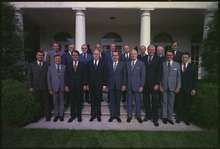
Shultz was United States Secretary of the Treasury from June 1972 to May 1974. During his tenure, he was concerned with two major issues: the continuing domestic administration of Nixon's "New Economic Policy," begun under Secretary John Connally (Shultz privately opposed its three elements), and a renewed dollar crisis that broke out in February 1973.[8][18]
Domestically Shultz enacted the next phase of the NEP: lifting price controls begun in 1971. This phase was a failure, resulting in high inflation, and price freezes were reestablished five months later.[18]
Meanwhile, Shultz's attention was increasingly diverted from the domestic economy to the international arena. In 1973 he participated in an international monetary conference in Paris that grew out of the 1971 decision to abolish the gold standard, a decision Shultz and Paul Volcker had supported (see Nixon Shock). The conference formally abolished the Bretton Woods system, causing all currencies to float. During this period Shultz co-founded the "Library Group," which became the G7. Shultz resigned shortly before Nixon to return to private life.[18]
Business executive
In 1974, he left government service to become executive vice president of Bechtel Group, a large engineering and services company. He was later its president and a director.
Under Shultz's leadership, Bechtel received contracts for many large construction projects including from Saudi Arabia. In the year before he left Bechtel, the company reported a 50% increase in revenue.[19]
Reagan Administration
Shultz is one of only two individuals to serve in four United States Cabinet positions within the United States government, the other being Elliot Richardson.
Secretary of State
On July 16, 1982, Shultz was appointed by President Ronald Reagan as the 60th U.S. Secretary of State, replacing Alexander Haig, who had resigned. Shultz served for six and a half years, the longest tenure since Dean Rusk's.[20] The possibility of a conflict of interest in his position as secretary of state after being in the upper management of the Bechtel Group was raised by several senators during his confirmation hearings. Shultz briefly lost his temper in response to some questions on the subject but was nevertheless unanimously confirmed by the Senate.[21]
Shultz relied primarily on the Foreign Service to formulate and implement Reagan's foreign policy. As reported in the State Department's official history, "by the summer of 1985, Shultz had personally selected most of the senior officials in the Department, emphasizing professional over political credentials in the process [...] The Foreign Service responded in kind by giving Shultz its 'complete support,' making him one of the most popular Secretaries since Dean Acheson."[20] Shultz's success came from not only the respect he earned from the bureaucracy but the strong relationship he forged with Reagan, who trusted him completely.[22]
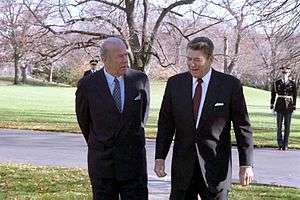
Relations with China
Shultz inherited negotiations with China over Taiwan from his predecessor. Under the terms of the Taiwan Relations Act, the United States was obligated to assist in Taiwan's defense, which included the sale of arms. The Administration debate on Taiwan, especially over the sale of military aircraft, resulted in a crisis in relations with China, which was alleviated only in August 1982, when, after months of arduous negotiations, the United States and China issued a joint communiqué on Taiwan in which the United States agreed to limit arms sales and China agreed to seek a "peaceful solution."[23]
Relations with Europe and the Soviet Union
By the summer of 1982, relations were strained not only between Washington and Moscow but also between Washington and key capitals in Western Europe. In response to the imposition of martial law in Poland the previous December, the Reagan administration had imposed sanctions on a pipeline between West Germany and the Soviet Union. European leaders vigorously protested sanctions that damaged their interests but not U.S. interests in grain sales to the Soviet Union. Shultz resolved this "poisonous problem" in December 1982, when the United States agreed to abandon sanctions against the pipeline and the Europeans agreed to adopt stricter controls on strategic trade with the Soviets.[24]
A more controversial issue was the NATO Ministers' 1979 "dual track" decision: if the Soviets refused to remove their SS-20 medium range ballistic missiles within four years, then the Allies would deploy a countervailing force of cruise and Pershing II missiles in Western Europe. When negotiations on these intermediate nuclear forces (INF) stalled, 1983 became a year of protest. Shultz and other Western leaders worked hard to maintain allied unity amidst popular anti-nuclear demonstrations in Europe and United States. In spite of Western protests and Soviet propaganda, the allies began deployment of the missiles as scheduled in November 1983.[24]
US-Soviet tensions were raised by the announcement in March 1983 of the Strategic Defense Initiative, and exacerbated by the Soviet shoot-down of Korean Air Lines Flight 007 near Moneron Island on September 1. Tensions reached a height with the Able Archer 83 exercises in November 1983, during which the Soviets feared a pre-emptive American attack.[25]
Following the missile deployment and the exercises, both Shultz and Reagan resolved to seek further dialogue with the Soviets.[24][26]
When President Mikhail Gorbachev of Russia came to power in 1985, Shultz advocated that Reagan pursue a personal dialogue with him. Reagan gradually changed his perception of Gorbachev's strategic intentions in 1987, when the two leaders signed the Intermediate Range Nuclear Forces Treaty.[27] The treaty, which eliminated an entire class of missiles in Europe, was a milestone in the history of the Cold War. Although Gorbachev took the initiative, Reagan was well prepared by the State Department to negotiate.[28]
Two more events in 1988 persuaded Shultz that Soviet intentions were changing. First, the Soviet Union's initial withdrawal from Afghanistan indicated that the Brezhnev Doctrine was dead. "If the Soviets left Afghanistan, the Brezhnev Doctrine would be breached, and the principle of 'never letting go' would be violated," Shultz reasoned.[27] The second event, according to Keren Yarhi-Milo of Princeton University, happened during the 19th Communist Party Conference, "at which Gorbachev proposed major domestic reforms such as the establishment of competitive elections with secret ballots; term limits for elected officials; separation of powers with an independent judiciary; and provisions for freedom of speech, assembly, conscience, and the press."[27] The proposals indicated that Gorbachev was making revolutionary and irreversible changes.[27]
Middle East diplomacy
In response to the escalating violence of the Lebanese civil war, Reagan sent a Marine contingent to protect the Palestinian refugee camps and support the Lebanese Government. The October 1983 bombing of the Marine barracks in Beirut killed 241 U.S. servicemen, after which the deployment came to an ignominious end.[20] Shultz subsequently negotiated an agreement between Israel and Lebanon and convinced Israel to begin partial withdrawal of its troops in January 1985 despite Lebanon's contravention of the settlement.[29]
During the First Intifada (see Arab–Israeli conflict), Shultz "proposed ... an international convention in April 1988 ... on an interim autonomy agreement for the West Bank and Gaza Strip, to be implemented as of October for a three-year period".[30] By December 1988, after six months of shuttle diplomacy, Shultz had established a diplomatic dialogue with the Palestine Liberation Organization, which was picked up by the next Administration.[20]
Latin America
Shultz was known for outspoken opposition to the "arms for hostages" scandal that would eventually become known as the Iran-Contra Affair. In 1983 testimony before Congress, he said that the Sandinista government in Nicaragua was "a cancer in our own land mass" that must be "cut out". He was also opposed to any negotiation with the government of Daniel Ortega: "Negotiations are a euphemism for capitulation if the shadow of power is not cast across the bargaining table."
Later life
After leaving public office, Shultz became the first prominent Republican to call for the legalization of recreational drugs. He went on to add his signature to an advertisement, published in The New York Times on June 8, 1998, headlined "We believe the global war on drugs is now causing more harm than drug abuse itself." In 2011, he was part of the Global Commission on Drug Policy, which called for a public health and harm reduction approach towards drug use, alongside other luminaries such as Kofi Annan, Paul Volcker, and George Papandreou.[31]
Shultz was an early advocate of the presidential candidacy of George W. Bush, whose father, George H. W. Bush, was Reagan's vice president. In April 1998, Shultz hosted a meeting at which George W. Bush discussed his views with policy experts including Michael Boskin, John Taylor and Condoleezza Rice, who were evaluating possible Republican candidates to run for president in 2000. At the end of the meeting, the group felt they could support Bush's candidacy, and Shultz encouraged him to enter the race.[32][33]
He then served as an advisor for Bush's presidential campaign during the 2000 election and a senior member of the "Vulcans", a group of policy mentors for Bush that also included Rice, Dick Cheney, and Paul Wolfowitz. One of his most senior advisors and confidants was former ambassador Charles Hill. Shultz has been called the father of the "Bush Doctrine" because of his advocacy of preventive war.[34] He generally defended the Bush administration's foreign policy.[34] He also occasionally advised Bush and his administration, such as in a January 2006 meeting at the White House of former Secretaries of Defense and State to discuss United States foreign policy with Bush administration officials.
In 2005, Shultz spoke out against the Cuban embargo, calling the policy "insane".[35] He argued that free trade would help bring down Fidel Castro's regime and that the embargo led only to continued repression.
In 2003, Shultz served as co-chair (along with Warren Buffett) of California's Economic Recovery Council, an advisory group to the campaign of California gubernatorial candidate Arnold Schwarzenegger.
On January 15, 2008, Shultz co-authored (with William Perry, Henry Kissinger and Sam Nunn) an opinion paper in The Wall Street Journal that called on governments to embrace the vision of a world free of nuclear weapons.[36] The four have created the Nuclear Threat Initiative to advance this agenda. Nunn reinforced that agenda during a speech at the Harvard Kennedy School on October 21, 2008, saying, "I'm much more concerned about a terrorist without a return address that cannot be deterred than I am about deliberate war between nuclear powers. You can't deter a group who is willing to commit suicide. We are in a different era. You have to understand the world has changed."[37] In 2010, the four were featured in the documentary film Nuclear Tipping Point, which discussed their agenda.
On January 11, 2011, Shultz wrote a letter to President Barack Obama urging him to pardon Jonathan Pollard. He stated, "I am impressed that the people who are best informed about the classified material Pollard passed to Israel, former CIA Director James Woolsey and former Chairman of the Senate Intelligence Committee Dennis DeConcini, favor his release".[38][39]
_(cropped).jpg)
Shultz favors a revenue-neutral carbon tax as the most economically efficient means of mitigating anthropogenic climate change. In April 2013, he co-wrote, with economist Gary Becker, an opinion article in the Wall Street Journal that concluded that "a revenue-neutral carbon tax would benefit all Americans by eliminating the need for costly energy subsidies while promoting a level playing field for energy producers."[2] He repeated this call in a September 2014 talk at MIT.[3] In March 2015, Shultz wrote in The Washington Post that he recommended "level[ing] the playing field for competing sources of energy so that costs imposed on the community are borne by the sources of energy that create them, most particularly carbon dioxide," and doing so through a carbon tax that is "revenue-neutral, returning all net funds generated to the taxpayers so that no fiscal drag results and the revenue would not be available for politicians to spend on pet projects."[4] In 2017, Shultz cofounded the Climate Leadership Council, along with Reagan Secretary of State James Baker and George W. Bush Secretary of the Treasury Henry Paulson.[5] In 2017, this group of "Republican elder statesmen" proposed that conservatives embrace a fee and dividend form of carbon tax (in which all revenue generated by the tax is rebated to the populace in the form of lump-sum dividends), as a policy to deal with anthropogenic climate change. The group also included Martin S. Feldstein and N. Gregory Mankiw.[6]
In April 2016, he was one of eight former Treasury secretaries who called on the United Kingdom to remain a member of the European Union ahead of the "Brexit" referendum in June.[40]
Shultz is a leader of the Climate Leadership Council, along with Henry Paulson and James Baker.[5]
Theranos scandal
From 2011 to 2015 Shultz was a member of the board of directors of Theranos, a health technology company that became known for its false claims to have devised revolutionary blood tests.[41][42][43] He was a prominent figure in the ensuing scandal. After joining the company's board in November 2011, he recruited other luminaries, including former secretary of state Henry Kissinger, former secretary of defense William Perry, and former U.S. Senator Sam Nunn. Shultz also promoted Theranos founder Elizabeth Holmes at major forums, including Stanford University's Institute for Economic Policy Research (SIEPR), and was on record supporting her in major media publications. This helped Holmes in her efforts to raise money from investors.[44][45]
Shultz's grandson, Tyler Shultz, joined Theranos in September 2013 after graduating from Stanford University with a degree in biology.[46] Tyler was forced to leave the company in 2014 after raising concerns about its testing practices with Holmes and his grandfather. George Shultz initially did not believe Tyler's warnings, pressured him to keep quiet,[47][48] and continued to advocate for Holmes and Theranos.[49] Tyler eventually contacted reporter John Carreyrou (who went on to expose the scandal in The Wall Street Journal), but as summarized by ABC Nightline, "it wasn’t long before Theranos got wind of it and attempted to use George Shultz to silence his grandson."[50] Tyler went to his grandfather's house to discuss the allegations, but was surprised to encounter Theranos attorneys there, who pressured him to sign a document.[50] As recounted in the documentary The Inventor: Out for Blood in Silicon Valley, they questioned Tyler in a manner that George described on April 4, 2017, as verbal assault. Tyler did not sign any agreements, even though George pressured him to: "My grandfather would say, like, things like 'your career would be ruined if [Carreyrou's] article comes out.'"[50] Tyler and his parents spent nearly $500,000 on legal fees, selling their house to raise the funds, in fighting Theranos's accusations of violating the NDA and divulging trade secrets.[50]
When media reports exposed controversial practices there in 2015, George Shultz moved to Theranos's board of counselors. Theranos was shut down on September 4, 2018.[51] In a 2019 media statement, Shultz praised his grandson for not having shrunk "from what he saw as his responsibility to the truth and patient safety, even when he felt personally threatened and believed that I had placed allegiance to the company over allegiance to higher values and our family. ... Tyler navigated a very complex situation in ways that made me proud."[50]
Other memberships held
_(cropped).jpg)
Shultz is the chairman of JPMorgan Chase's international advisory council and an honorary director of the Institute for International Economics. He is a member of the Hoover Institution at Stanford University, the Washington Institute for Near East Policy (WINEP) board of advisors, the New Atlantic Initiative, the prestigious Mandalay Camp at the Bohemian Grove, the Committee for the Liberation of Iraq, and the Committee on the Present Danger. He serves as an advisory board member for the Partnership for a Secure America and Citizens' Climate Lobby.[52] He is honorary chairman of the Israel Democracy Institute.[53] Shultz is an advisory board member of Spirit of America, a 501(c)(3) organization that supports the safety and success of Americans serving abroad and the local people and partners they seek to help.[54] At the Hoover Institution he participates in discussions on campus and in the Hoover Virtual Policy Briefing series, giving a talk, "Learning From Experience", on July 21, 2020.[55]
Shultz formerly served on the board of directors of the Bechtel Corporation, of the Charles Schwab Corporation, and from 1996 to 2005 of Gilead Sciences. He is a co-chairman of the North American Forum and serves on the board for Accretive Health.
Shultz sits on the board of directors for Xyleco.[56] He is also a senior advisor to the Nuclear Threat Initiative.
Family
While serving with the Marines in Hawaii, he met military nurse lieutenant Helena Maria O'Brien (1915–1995). They married on February 16, 1946, and had five children: Margaret Ann Tilsworth, Kathleen Pratt Shultz Jorgensen, Peter Milton Shultz, Barbara Lennox Shultz White, and Alexander George Shultz.[7][57] Helena died in 1995 of pancreatic cancer.
In 1997, Shultz married Charlotte Mailliard Swig, a prominent San Francisco philanthropist and socialite.[58]
Tyler Shultz, his grandson, is a whistleblower who exposed falsified lab tests conducted at Theranos during his employment, while George Shultz was a board member at the company (see "Theranos scandal" section).[59]
Honors and prizes
|
|
- 2001 – Eisenhower Medal for Leadership.[64]
- 2000 – Woodrow Wilson Award for Public Service.
- 1996 – Koret Prize.[64]
- 1992 – Seoul Peace Prize (Korea).[64]
- 1992 – United States Military Academy, Sylvanus Thayer Award.
- 1989 – Presidential Medal of Freedom.[64]
- 1989 – Order of the Rising Sun with Paulownia Flowers, Grand Cordon (Japan).[68]
- 1986 – Freedoms Foundation, George Washington Medal.[64]
- 1986 – U.S. Senator John Heinz Award (Jefferson Awards) For Public Service.[69]
- 1970 – Fellow of the American Academy of Arts and Sciences.[70]
Honorary degrees
Honorary degrees have been conferred from the universities of Columbia, Notre Dame, Loyola, Pennsylvania, Rochester, Princeton, Carnegie Mellon, City University of New York, Yeshiva, Northwestern, Technion, Tel Aviv, Weizmann Institute of Science, Baruch College of New York, Williams College, Hebrew University of Jerusalem, Tbilisi State University in the Republic of Georgia, and Keio University in Tokyo.[64]
Selected works
- Shultz, George P. and Goodby, James E. The War that Must Never be Fought, Hoover Press, ISBN 978-0-8179-1845-3, 2015.
- Shultz, George P. and Shoven, John B. Putting Our House in Order: A Guide to Social Security and Health Care Reform. New York: W.W. Norton, 2008
- Economics in Action: Ideas, Institutions, Policies, Hoover Institution on War, Revolution and Peace, Stanford University, 1995.
- Shultz, George P. Turmoil and Triumph: My Years as Secretary of State, New York: Scribner's 1993.
- U.S. Policy and the Dynamism of the Pacific; Sharing the Challenges of Success, East-West Center (Honolulu), Pacific Forum, and the Pacific and Asian Affairs Council, 1988.
- The U.S. and Central America: Implementing the National Bipartisan Commission Report: Report to the President from the Secretary of State, U.S. Department of State (Washington, DC), 1986.
- Risk, Uncertainty, and Foreign Economic Policy, D. Davies Memorial Institute of International Studies, 1981.
- (With Kenneth W. Dam) Economic Policy beyond the Headlines, Stanford Alumni Association, 1977.
- Leaders and Followers in an Age of Ambiguity, New York University Press (New York), 1975.
- (With Albert Rees) Workers and Wages in an Urban Labor Market, University of Chicago Press, 1970.
- (With Arnold R. Weber) Strategies for the Displaced Worker: Confronting Economic Change, Harper (New York), 1966.
- (Editor and author of introduction, with Robert Z. Aliber) Guidelines, Informal Controls, and the Market Place: Policy Choices in a Full Employment Economy, University of Chicago Press (Chicago), 1966.
- (Editor, with Thomas Whisler) Management Organization and the Computer, Free Press (New York), 1960.
- (Editor, with John R. Coleman) Labor Problems: Cases and Readings, McGraw (New York), 1953.
- Pressures on Wage Decisions: A Case Study in the Shoe Industry, Wiley (New York), 1951.
- (With Charles Andrew Myers) The Dynamics of a Labor Market: A Study of the Impact of Employment Changes on Labor Mobility, Job Satisfaction, and Company and Union Policies, Prentice-Hall (Englewood Cliffs, NJ), 1951.
See also
- Foreign policy of the Reagan administration
- International Conference on Nuclear Disarmament
- Nuclear Tipping Point
References
- "George P. Shultz". Hoover Institution.
- Shultz, George; Becker, Gary (April 7, 2013). "Why We Support a Revenue-Neutral Carbon Tax: Coupled with the elimination of costly energy subsidies, it would encourage competition". The Wall Street Journal. Retrieved December 22, 2016.
- Dizikes, Peter (October 1, 2014). "George Shultz: "Climate is changing," and we need more action; Former secretary of state – and former MIT professor – urges progress on multiple fronts". MIT News. Massachusetts Institute of Technology. Retrieved December 10, 2015.
- Shultz, George (March 13, 2015). "A Reagan approach to climate change". The Washington Post. Retrieved December 21, 2016.
- John Schwartz (February 7, 2017). "'A Conservative Climate Solution': Republican Group Calls for Carbon Tax". The New York Times. Retrieved April 17, 2017.
The group, led by former Secretary of State James A. Baker III, with former Secretary of State George P. Shultz and Henry M. Paulson Jr., a former secretary of the Treasury, says that taxing carbon pollution produced by burning fossil fuels is "a conservative climate solution" based on free-market principles.
- https://www.clcouncil.org/wp-content/uploads/2017/02/TheConservativeCaseforCarbonDividends.pdf
- Katz, Bernard S.; C. Daniel Vencill (1996). Biographical Dictionary of the United States Secretaries of the Treasury, 1789–1995. Greenwood Publishing Group. pp. 320–332. ISBN 978-0313280122.
- Vellani, Robert (2003). "George P. Shultz" (via Fairfax County Public Library). In Arnold Markoe; Kenneth T. Jackson (eds.). Scribner Encyclopedia of American Lives, Thematic Series: Sports Figures. New York: Charles Scribner's Sons. GALE|K3436600565. Retrieved February 7, 2012. (subscription required)
- Burnett, Paul. Problems and Principles: George P. Shultz and the Uses of Economic Thinking Archived June 15, 2018, at the Wayback Machine, University of California, Berkeley. Accessed June 14, 2018. "I went to the public school for a while, then I went to a school called the Englewood School for Boys, now merged with the Dwight School. In my last two years, I went to the Loomis School in Windsor, Connecticut."
- Shultz, George Pratt. Woodrow Wilson School of Public and International Affairs (ed.). "The Agricultural Program of the Tennessee Valley Authority". Cite journal requires
|journal=(help) - U.S. House of Representatives (December 21, 2004). "Joint Resolution: Recognizing the 60th anniversary of the Battle of Peleliu". Congressional Record. Government Printing Office. 150. Archived from the original on March 22, 2012. Retrieved February 7, 2012. H.J. Res. 102
- project editor, Tracie Ratiner. (2006). Encyclopedia of World Biography (2nd ed.). Detroit, Michigan: Thomson Gale. ISBN 1-4144-1041-7. OCLC 1414410417. Retrieved April 26, 2009.
- "Ronald Reagan: Nomination of George P. Shultz To Be Secretary of State". www.presidency.ucsb.edu. Retrieved December 15, 2017.
- "The Chicago School and Its Impact" Commanding Heights: George Shultz, October 2, 2000
- Frum, David (2000). How We Got Here: The '70s. New York: Basic Books. p. 243. ISBN 0-465-04195-7.
- Richard J. Ellis (2015). The Development of the American Presidency (2nd ed.). New York: Routledge. pp. 387–388. ISBN 978-1317552963.
- "Former Directors of OMB and BOB". Office of Management and Budget. Retrieved August 22, 2016.
- "History of the Treasury: George P. Shultz". United States Department of the Treasury, Office of the Curator. 2001. Archived from the original on February 1, 2009. Retrieved February 12, 2009.
- Lueck, Thomas (June 26, 1982). "Bechtel Loses Another Officer to Reagan's Cabinet". Retrieved August 11, 2016.
- "Secretary Shultz Takes Charge". Short History of the Department of State. United States Department of State, Office of the Historian. Retrieved February 13, 2009.
- Greider, William (December 9, 1982). "The Boys From Bechtel". Rolling Stone. Retrieved August 11, 2016.
- van Dijk, Ruud et al, eds. (2008) Encyclopedia of the Cold War, Vol. 1. New York: Routledge, p. 787.
- "Reagan's Foreign Policy". Short History of the Department of State. United States Department of State, Office of the Historian. Retrieved February 13, 2009.
- "The United States in Europe". Short History of the Department of State. United States Department of State, Office of the Historian. Retrieved February 13, 2009.
- Andrew, Christopher; Gordievsky, Oleg (1992). KGB: The Inside Story of Its Foreign Operations from Lenin to Gorbachev. Harpercollins. p. 600. ISBN 0-06-016605-3.
- Reagan, Ronald (1990). An American Life. New York: Simon and Schuster. pp. 585, 588–589. ISBN 1-59248-531-6.
- Yarhi-Milo, Keren (Summer 2013). "In the Eye of the Beholder: How Leaders and Intelligence Communities Assess the Intentions of Adversaries". International Security. 38 (1): 31. doi:10.1162/isec_a_00128. Retrieved August 1, 2013.
- "Gorbachev and Perestroika". Short History of the Department of State. United States Department of State, Office of the Historian. Retrieved February 13, 2009.
- "George P. Shultz". United States Department of State, Office of the Historian. Retrieved February 13, 2009.
- Oded, Eran (2002). "Arab-Israel Peacemaking." The Continuum Political Encyclopedia of the Middle East. Ed. Avraham Sela. New York: Continuum. p. 135
- "The Global Commission on Drug Policy – List of Commissioners". Switzerland: The Global Commission on Drug Policy. December 1, 2016. Retrieved December 16, 2016.
- "George W. Bush Chronology". Boston: WGBH-TV. October 12, 2004. Retrieved February 28, 2011.
- "The Choice 2004". Frontline. Boston, MA. October 12, 2004. PBS. WGBH-TV. Retrieved February 28, 2011.
- Henninger, Daniel (April 29, 2006). "Father of the Bush Doctrine". The Wall Street Journal. Retrieved August 12, 2008.
- George Shultz, Charlie Rose (December 22, 2005). Charlie Rose interview with George Shultz. Charlie Rose Inc.
- "Toward a Nuclear-Free World", The Wall Street Journal, January 15, 2008
- Maclin, Beth (October 20, 2008) "A Nuclear weapon-free world is possible, Nunn says", Belfer Center, Harvard University. Retrieved on 2008-10-21.
- "George Shultz calls for Jonathan Pollard's release". The Washington Post. January 11, 2011. Retrieved November 12, 2013.
- "The truth about Jonathan Pollard". CNN. June 22, 2012. Retrieved November 12, 2013.
- "Staying in EU 'best hope' for UK's future say ex-US Treasury secretaries". BBC News. April 20, 2016.
- John Carreyrou (2018). Bad Blood: Secrets and Lies in a Silicon Valley Startup. Knopf Doubleday. ISBN 978-1-5247-3166-3.
- Levine, Matt (March 14, 2018). "The Blood Unicorn Theranos Was Just a Fairy Tale". Bloomberg View. Retrieved March 14, 2018.
- "A singular board at Theranos". Fortune. June 12, 2014. Retrieved September 22, 2015.
- Auletta, Ken (December 8, 2014). "Blood, Simpler". ISSN 0028-792X. Retrieved February 4, 2019.
- Stanford Institute for Economic Policy Research (SIEPR), George Shultz interviews Elizabeth Holmes at the 12th SIEPR Economic Summit, retrieved February 4, 2019
- "Tyler Shultz. CEO, Co-founder at Flux Biosciences". LinkedIn. Retrieved February 5, 2020.
- Carreyrou, John (November 18, 2016). "Theranos Whistleblower Shook the Company—and His Family". Wall Street Journal – via www.wsj.com.
- Garde,STAT, Rebecca Robbins,Damian. "7 Questions to Watch in the Theranos Saga". Scientific American.
- Carreyrou, John (November 18, 2016). "Theranos Whistleblower Shook the Company – and His Family". Wall Street Journal. ISSN 0099-9660. Retrieved February 4, 2019.
- "Ex-Theranos CEO Elizabeth Holmes says 'I don't know' 600-plus times in never-before-broadcast deposition tapes". ABC News. February 20, 2019. Retrieved March 22, 2019.
- "Blood-Testing Firm Theranos to Dissolve". Wall Street Journal.
- "Advisory Board – Citizens' Climate Lobby". Retrieved January 21, 2018.
- "International Advisory Council". The Israel Democracy Institute. Retrieved November 12, 2013.
- https://spiritofamerica.org/staff/hon-george-p-shultz
- https://www.hoover.org/research/george-p-shultz-learning-experience
- "Board of Directory". Xyleco. Retrieved January 6, 2019.
- "George P. Shultz" (fee, via Fairfax County Public Library). Contemporary Authors Online. Detroit, MI: Gale. 2010. GALE|H1000090903. Retrieved February 7, 2012.. Gale Biography In Context. (subscription required)
- Donnally, Trish (August 16, 1997). "Swig Tames Her Tiger". San Francisco Chronicle. Retrieved April 26, 2009.
- Carreyrou, John (November 17, 2016). "Theranos Whistleblower Shook the Company—And His Family". Wall Street Journal. Retrieved November 17, 2016.
- "Former Secretary of State George Shultz to be Honorary Reagan Fellow at EC Endowed scholarship created in his name". Eureka College.
- "Bývalý americký ministr zahraničí USA dostane medaili Jana Masaryka - Krajane.net". www.krajane.net.
- "The American Academy in Berlin – The Henry A. Kissinger Prize 2012". Archived from the original on May 23, 2012. Retrieved May 25, 2012.
- Commonwealth of Australia Gazette, No. S134, September 14, 2011.
- Hoover Foundation: Fellow, bio notes.
- Nuclear Arms Control Leaders Receive Prestigious Rumford Prize from the American Academy.
- "Archived copy". Archived from the original on March 5, 2016. Retrieved May 15, 2012.CS1 maint: archived copy as title (link)
- "American Economic Association". www.aeaweb.org.
- Sleeman, Elizabeth. (2003). The International Who's Who 2004, p. 1547.
- "National – Jefferson Awards Foundation". Archived from the original on November 24, 2010. Retrieved August 5, 2013.
- "Book of Members, 1780–2010: Chapter S" (PDF). American Academy of Arts and Sciences. Retrieved April 13, 2011.
Further reading
- Dan Rather and Gary Paul Gates, The Palace Guard (1974)
- William Safire, Before the Fall: An Inside Look at the Pre-Watergate White House (1975)
- Laurence I. Barrett, Gambling with History: Reagan in the White House (1983)
- Allen J. Matsuow, Nixon's Economy: Boom, Busts, Dollars, and Votes (1998)
- TIME (July 5, 1982)
- Newsweek (July 5, 1982, February 7, 1983, May 31, 1993)
- The New Republic (Dec 15, 1986)
- The Economist (Apr 2, 1988 and December 3, 1988)
- Skoug, Kenneth N. (1996). The United States and Cuba Under Reagan and Shultz: A Foreign Service Officer Reports. Westport, CT: Praeger.
- Wilson, James Graham (2014). The Triumph of Improvisation: Gorbachev's Adaptability, Reagan's Engagement, and the End of the Cold War. Ithaca: Cornell University Press. ISBN 978-0801452291.
- LaFranchi, Howard (March 9, 2010). "The World According to George Schultz". The Christian Science Monitor Weekly. Harklan, IA: The Christian Science Publishing Society. 112 (16): 3, 22–28. ISSN 2166-3262.
External links
| Wikiquote has quotations related to: George Shultz |
| Wikimedia Commons has media related to George P. Shultz. |
- Turmoil & Triumph: The George Shultz Years
- "George P. Shultz". Hoover Institution, Stanford University. 2008. Archived from the original on September 10, 2005. Cite journal requires
|journal=(help). - Association for the Study of the Middle East and Africa(ASMEA)
- Roberts, Russ (September 3, 2007). "George Shultz on Economics, Human Rights and the Fall of the Soviet Union". EconTalk. Library of Economics and Liberty.
Video
- Appearances on C-SPAN
- Turmoil & Triumph: The George Shultz Years"
- George Shultz discusses his book Putting Our House in Order on YouTube (filmed on April 15, 2008, at Stanford)
- George Shultz on panel aired on Democracy Now! program, September 6, 2007
- George Shultz on Charlie Rose
- Booknotes interview with Shultz on Turmoil and Triumph: My Years as Secretary of State, June 27, 1993.
| Academic offices | ||
|---|---|---|
| Preceded by W. Allen Wallis |
Dean of the Booth School of Business 1962–1969 |
Succeeded by Sidney Davidson |
| Political offices | ||
| Preceded by W. Willard Wirtz |
United States Secretary of Labor 1969–1970 |
Succeeded by James Day Hodgson |
| Preceded by Bob Mayo as Director of the Bureau of the Budget |
Director of the Office of Management and Budget 1970–1972 |
Succeeded by Caspar Weinberger |
| Preceded by John Connally |
United States Secretary of the Treasury 1972–1974 |
Succeeded by William E. Simon |
| Preceded by Alexander Haig |
United States Secretary of State 1982–1989 |
Succeeded by James Baker |

